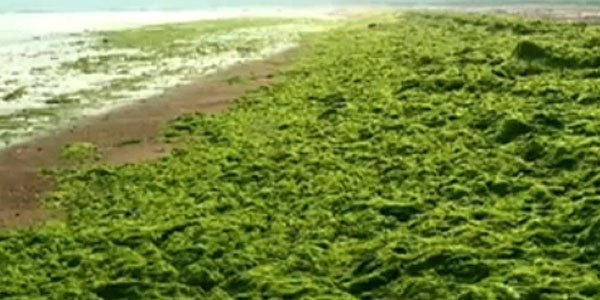Smelly Algae Bloom Stretches Across China's Coast

Those who enjoy beaches along the coast of China may not want to plan an annual trip this year. In what seems to be the largest bloom since 2009, an estimated 7,500 acres have been affected by a green tide near the coastal city of Qingdao. The bloom isn’t dangerous to humans, but is bad for ocean life that is forced to deal with the biomass. While humans on China’s beaches have often been seen swimming around the green stuff and even gleefully playing with it, by the time the biomass begins rotting, things likely won’t seem so fun as the air around the bloom will begin smelling like rotten eggs.
The green stuff is known as “sea lettuce” in China, and while that does seem like a harmful title for the mass of algae infecting the water, the State Oceanic Administration and other local officials are in a tizzy over the mess. According to the NY Times, the government is calling the bloom a “large-scale algae disaster,” and has been taking major strides to clean up the beaches. You can see some of the icky alge as well as the clean-up efforts in the video below, courtesy of The Guardian.
So far, the government has managed to clear a whopping 19,800 tons of the algae off of the beaches near Qingdao. The algae can then be used as “as an ingredient in fertilizers or biomass energy production.” However, despite the huge efforts to keep the algae off of the beaches, it’s difficult to do so when there is an infected area larger than the state of Connecticut to contend with.
The algae phenomenon has occurred along China’s beaches in the past, most notably during the 2008 Olympics when a sailing event would have been interrupted by the algae were it not for major clean-ups on the Chinese government’s end, reportedly to the tune of $30 million. A 2009 bloom was even bigger. Interestingly, the blooms only began appearing in the Yellow Sea in 2007.
Currently, officials don’t have any idea exactly what spurs the blooms to appear all over the water, but the Times also reports that increased seaweed farming may be to blame for the blooms’ appearances. According to the Daily Star, other possible culprits include overuse and inappropriate use of fertilizer and cities failing to treat sewage properly. So, think of those latter two possibilities before deciding to take a swim.
Living near a beach might be a dream for many people, but just like most climates, living by the water comes with its own slew of problems, which can include species invasions, turtle problems, bad weather, and apparently, even disgusting algae.
CINEMABLEND NEWSLETTER
Your Daily Blend of Entertainment News

Jessica Rawden is Managing Editor at CinemaBlend. She’s been kicking out news stories since 2007 and joined the full-time staff in 2014. She oversees news content, hiring and training for the site, and her areas of expertise include theme parks, rom-coms, Hallmark (particularly Christmas movie season), reality TV, celebrity interviews and primetime. She loves a good animated movie. Jessica has a Masters in Library Science degree from Indiana University, and used to be found behind a reference desk most definitely not shushing people. She now uses those skills in researching and tracking down information in very different ways.

Severance's Helly Actress Said Her Character Will Feel 'Envy' Toward Herself This Season, And Her Reasoning Why Has Left Me With A Big Question

‘I Hope This Isn’t A Frustrating Answer To You’: Challengers’ Writer Shares His Take On The Film’s Divisive Ending

After Timothée Chalamet And Dave Chappelle Are Announced For SNL, Fans Are Asking The Relevant Questions
Most Popular






